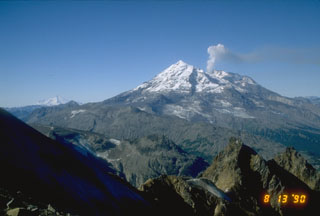Report on Redoubt (United States) — 1 April-7 April 2009
Smithsonian Institution / US Geological Survey
Weekly Volcanic Activity Report, 1 April-7 April 2009
Managing Editor: Sally Sennert.
Please cite this report as:
Global Volcanism Program, 2009. Report on Redoubt (United States) (Sennert, S, ed.). Weekly Volcanic Activity Report, 1 April-7 April 2009. Smithsonian Institution and US Geological Survey.
Redoubt
United States
60.485°N, 152.742°W; summit elev. 3108 m
All times are local (unless otherwise noted)
During 1-3 April, AVO reported that Redoubt continued to emit steam, gases, and minor amounts of ash visible on the Redoubt Hut web camera. On 1 and 2 April, satellite images showed a plume containing some ash extending about 65 km ENE at altitudes of 4.6-7.6 km (15,000-25,000 ft) a.s.l. Thermal anomalies detected in infrared images were most likely due to lava dome extrusion in the summit crater. On 3 April, AVO lowered the Volcanic Alert Level to Watch and the Aviation Color Code to Orange due to a decreased intensity of ash production. AVO overflights and photography confirmed that a lava dome was growing at the summit. Occasional avalanches of hot blocks from the dome traveled a short distance down the N flank.
On 4 April, a significant explosion produced an ash plume that rose to an altitude of 15.2 km (50,000 ft) a.s.l. and drifted SE. Seismic data indicated that a lahar traveled down the Drift River valley. AVO raised the Alert Level to Warning and the Aviation Color Code to Red, the highest levels. During 5-6 April, small earthquakes and intermittent tremor continued to be detected. The web camera showed a continuously emitted plume of primarily steam and gas that rose to an altitude of 7.7 km (25,300 ft) a.s.l. and drifted SE. A small, intermittent plume rose from the NW base of the volcano, possibly from the interaction of hot debris with snow, ice, and water. On 6 April, AVO again lowered the Volcanic Alert Level to Watch and the Aviation Color Code to Orange due to seismic patterns and emissions of only very minor ash. A gas-and-steam plume rose to an altitude less than 7.7 km (25,300 ft) a.s.l. and drifted NE. On 7 April, a small steam-and-ash plume was seen on satellite imagery and drifted 16-24 km SE at altitudes of 4.6-6.1 km (15,000-20,000 ft) a.s.l.
Geological Summary. Redoubt is a glacier-covered stratovolcano with a breached summit crater in Lake Clark National Park about 170 km SW of Anchorage. Next to Mount Spurr, Redoubt has been the most active Holocene volcano in the upper Cook Inlet. The volcano was constructed beginning about 890,000 years ago over Mesozoic granitic rocks of the Alaska-Aleutian Range batholith. Collapse of the summit 13,000-10,500 years ago produced a major debris avalanche that reached Cook Inlet. Holocene activity has included the emplacement of a large debris avalanche and clay-rich lahars that dammed Lake Crescent on the south side and reached Cook Inlet about 3,500 years ago. Eruptions during the past few centuries have affected only the Drift River drainage on the north. Historical eruptions have originated from a vent at the north end of the 1.8-km-wide breached summit crater. The 1989-90 eruption had severe economic impact on the Cook Inlet region and affected air traffic far beyond the volcano.
Source: US Geological Survey Alaska Volcano Observatory (AVO)

